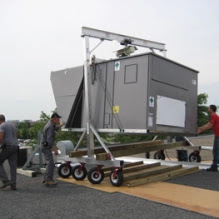The mobile gantry crane stands out as a game-changer in improving productivity on job sites. These versatile machines offer flexibility, efficiency, and reliability, making them an essential tool for various industries. Mobile gantry cranes streamline operations, reduce manual labor, and save valuable time from construction to manufacturing.
What Is a Mobile Gantry Crane?
A mobile gantry crane is a lightweight, portable lifting solution that handles heavy loads. Unlike fixed cranes, these can be easily moved to different locations, making them ideal for dynamic job sites. They typically have a sturdy frame, wheels or casters, and a hoist mechanism.
Key Features of Mobile Gantry Cranes
Portability: Equipped with wheels, these cranes can be easily relocated.
Adjustability: Many models allow for height and span adjustments to suit specific tasks.
Capacity: Mobile gantry cranes can lift anywhere from a few hundred pounds to several tons.
These features make mobile gantry cranes versatile tools that adapt to various environments.
Boosting Efficiency Through Mobility
One of the standout advantages of mobile gantry cranes is their ability to move seamlessly across job sites. This mobility reduces downtime and eliminates the need for multiple stationary cranes.
Reducing Setup Time
Traditional cranes often require extensive setup and installation. On the other hand, mobile gantry cranes are ready to go with minimal preparation. This efficiency translates to faster project completion and lower costs.
Enhancing Load Transportation
Moving heavy loads across a site becomes much simpler with a mobile gantry crane. Instead of relying on forklifts or manual labor, workers can use the crane to transport items safely and efficiently.
Versatility in Use
Mobile gantry cranes can handle a wide range of tasks. Whether lifting beams in construction or moving machinery in a warehouse, these cranes adapt to different job requirements.
Increasing Safety on Job Sites
Safety is a top priority on any job site. Mobile gantry cranes contribute to safer working conditions by reducing the physical strain on workers and minimizing risks associated with manual lifting.
Lower Risk of Injuries
Heavy lifting can lead to injuries, especially when workers move awkward or oversized loads. A mobile gantry crane takes on this burden, protecting employees from harm.
Stability and Control
These cranes are designed for stability, even when handling heavy loads. Operators have precise control over movements, reducing the chances of accidents.
Organized Workflows
By streamlining material handling, mobile gantry cranes create a more organized and less cluttered job site, reducing the likelihood of trip hazards and other safety issues.
Common Applications of Mobile Gantry Cranes
Mobile gantry cranes are used in various industries. Their adaptability makes them valuable tools in both indoor and outdoor environments.
Construction Sites
Mobile gantry cranes are perfect for lifting and placing beams, panels, and other heavy materials in construction. Their mobility allows workers to tackle multiple areas of a site without additional equipment.
Warehouses and Manufacturing
Mobile gantry cranes benefit warehouses by handling tasks like loading and unloading shipments. In manufacturing, they position machinery, molds, and other components precisely.
Maintenance and Repairs
Mobile gantry cranes are ideal for maintenance tasks, such as lifting engines or heavy machinery parts. Their portability ensures they can be brought to where repairs are needed.
Cost-Effectiveness of Mobile Gantry Cranes
Investing in a mobile gantry crane can significantly save costs over time. While the initial purchase may seem high, the long-term benefits outweigh the expense.
Reduced Labor Costs
A mobile gantry crane requires fewer workers for heavy lifting tasks. This can lower labor costs and improve efficiency.
Durability and Longevity
These cranes are built to last. A mobile gantry crane can serve a business for years, providing consistent value with proper maintenance.
Fewer Equipment Rentals
Because of their versatility, mobile gantry cranes eliminate the need to rent multiple types of equipment, saving money and simplifying logistics.
Choosing the Right Mobile Gantry Crane
Selecting the right mobile gantry crane for your needs requires careful consideration of several factors.
Load Capacity
Determine the maximum weight you’ll need to lift. Choose a crane with a capacity that meets or exceeds this requirement.
Size and Adjustability
Consider the dimensions of the crane, including height and span. Adjustable models are a great option for varying job site needs.
Wheels and Mobility
Check the type of wheels or casters the crane has. Ensure they are suitable for the surface conditions of your job site.
Material and Durability
Most mobile gantry cranes are made of aluminum or steel. Aluminum models are lightweight and corrosion-resistant, while steel ones offer greater strength.
Maintenance Tips for Long-Lasting Performance
Proper maintenance is crucial for ensuring the longevity and performance of your mobile gantry crane.
Regular Inspections
Inspect the crane for signs of wear, such as cracks, rust, or damaged wheels. Address any issues promptly to prevent accidents.
Lubrication
Keep moving parts, like the hoist and casters, well-lubricated. This reduces friction and ensures smooth operation.
Cleanliness
Keep the crane clean and free of debris. Regular cleaning prevents dirt buildup that can affect performance.
Operator Training
Ensure all operators are properly trained. Knowledgeable operators can use the crane efficiently and identify potential problems early.
Conclusion
Mobile gantry cranes are powerful tools for enhancing efficiency on job sites. Their mobility, versatility, and ease of use make them indispensable for the construction, manufacturing, and maintenance industries. By properly investing in and maintaining the right crane, businesses can enjoy safer workflows, reduced costs, and increased productivity.
Whether you’re lifting heavy beams or moving machinery, a mobile gantry crane is a reliable partner on the job site. With the right approach, this equipment can transform your work, helping you complete projects faster and more precisely.


